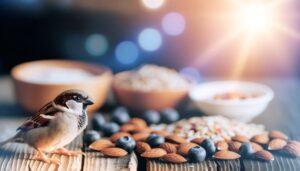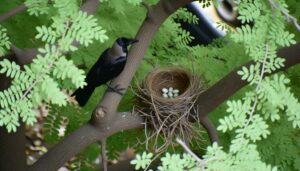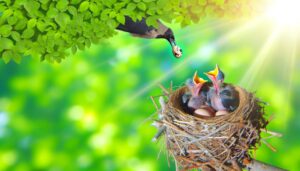How Much Food Does a Sparrow Eat Daily?
Sparrows typically eat around 15% of their body weight daily. For an average House Sparrow, which weighs approximately 30 grams, this equates to about 4.5 grams of food per day.
Their high metabolic rate requires frequent foraging sessions. Sparrows primarily consume seeds, grains, and insects, with dietary adjustments based on seasonal availability.
During winter, their diet focuses on seeds and grains, while spring brings an uptick in insect consumption for reproduction. Summer adds fruits to their diet.
Observing these nutrient shifts provides insights into sparrows' adaptability and survival strategies across various environments. Learn more to uncover fascinating details about their feeding behaviors.
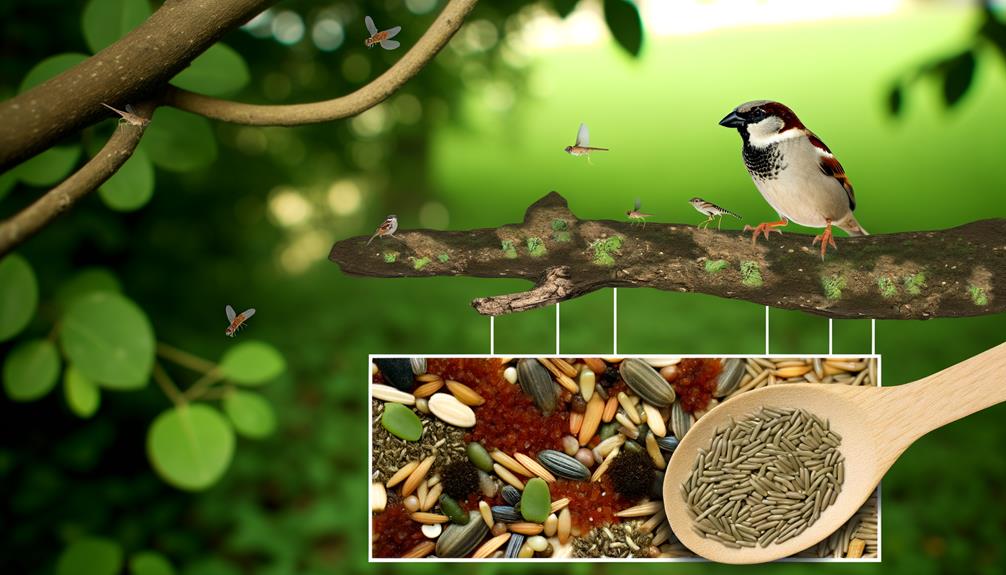
Key Takeaways
- Sparrows consume about 15% of their body weight in food daily.
- An average adult House Sparrow eats approximately 4.5 grams of food daily.
- Frequent feeding is needed due to their high metabolic rate.
- Their diet includes seeds, grains, and insects, varying seasonally.
- In spring and summer, sparrows consume more insects for protein.
Daily Food Intake
How much food does a sparrow consume on a daily basis?
Scientific observation reveals that sparrows, specifically the House Sparrow (Passer domesticus), typically consume approximately 15% of their body weight in food each day.
Given that the average adult House Sparrow weighs about 30 grams, this translates to an intake of around 4.5 grams of food daily.
This high metabolic rate necessitates frequent feeding to sustain their energy levels, particularly during periods of increased activity such as breeding or migration.
Observations indicate that sparrows spend a significant portion of their day foraging, which underscores the importance of food availability in their habitats.
The daily intake varies slightly depending on environmental conditions and the bird's physiological state, emphasizing their adaptive feeding behavior.
Types of Food
Sparrows exhibit a diverse diet that primarily includes seeds, grains, and insects, reflecting their opportunistic feeding habits. Their dietary preferences are influenced by availability and nutritional needs, demonstrating adaptability across different habitats. Seeds are a staple, offering essential carbohydrates and fats. Grains, often consumed from agricultural areas, provide additional energy. Insects, particularly during the breeding season, supply essential proteins necessary for chick development.
| Food Type | Nutritional Benefit | Examples |
|---|---|---|
| Seeds | Carbohydrates, Fats | Sunflower seeds, millet, and flaxseed |
| Grains | Energy, Carbohydrates | Wheat, barley, and oats |
| Insects | Protein, Amino Acids | Beetles, caterpillars, and grasshoppers |
This dietary diversity is crucial for sparrow survival and reproduction, enabling them to thrive in varied environments and ecological niches.
Seasonal Variations
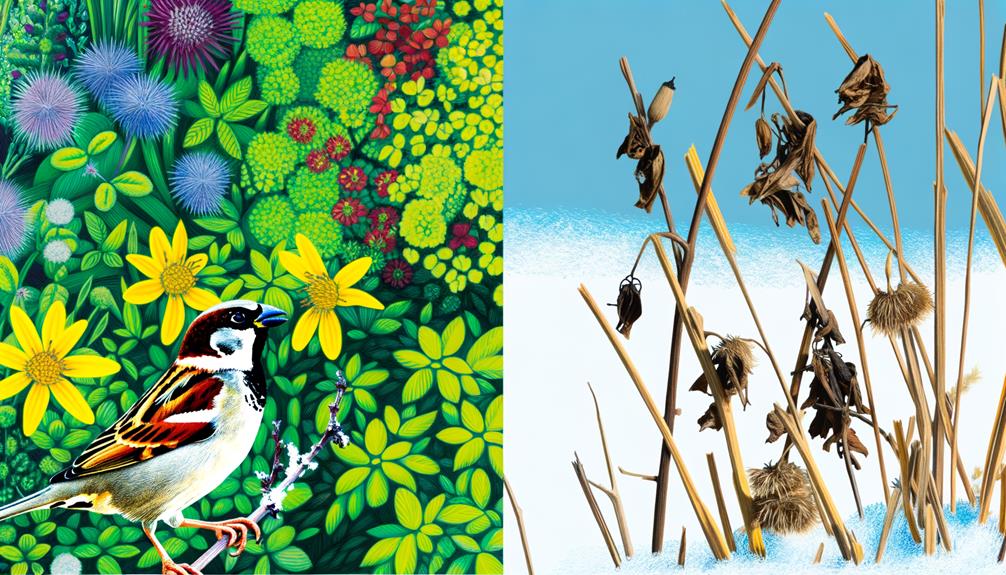
Seasonal variations heavily influence the dietary patterns of sparrows. Notable changes are observed in their feeding habits across different times of the year. During winter, sparrows mainly consume seeds and grains due to the scarcity of insects. As spring approaches, their diet shifts to include a higher proportion of insects, which provide essential proteins for reproduction. Summer offers an abundance of both plant and animal food sources that sustain their increased energy demands.
Winter Feeding Habits
During the winter months, a sparrow's feeding habits undergo significant changes driven by the scarcity of food resources and the necessity to maintain body heat.
Sparrows increase their food intake to build fat reserves, which are critical for thermoregulation. They primarily rely on seeds, as insect availability diminishes with colder temperatures. The metabolic rate of sparrows rises in winter, necessitating more frequent foraging to meet energy demands.
Observational studies indicate that sparrows spend more time searching for food during daylight hours, taking advantage of any available sunlight to conserve energy. Additionally, they often feed in groups to maximize efficiency and minimize the risk from predators.
These adaptive behaviors are essential for their survival in harsh winter conditions.
Spring Dietary Shifts
As temperatures rise and food availability increases in spring, sparrows exhibit notable shifts in their diet, incorporating a higher proportion of insects and other protein-rich sources to support reproductive activities and overall health.
Observational studies indicate that sparrows consume considerably more caterpillars, beetles, and other arthropods during this season. This dietary shift is driven by the increased nutritional demands of egg production and chick rearing. Protein and lipid intake become essential, enhancing the growth and development of the young.
Concurrently, the abundance of seeds and plant material remains part of their diet but at reduced proportions compared to winter. This seasonal adaptability underscores the sparrow's resilience and the intricate balance within their ecological niche.
Summer Food Sources
In the height of summer, sparrows diversify their diet further by incorporating a substantial amount of fruits, seeds, and insects, capitalizing on the peak availability of these resources.
The abundance of insects, such as caterpillars and beetles, provides essential protein required for growth and reproductive success. Additionally, ripened fruits, including berries, offer a rich source of vitamins and sugars, essential for maintaining energy levels. Seeds from grasses and other flowering plants become increasingly accessible, supplying necessary fats and carbohydrates.
This seasonal dietary shift not only supports the sparrows' heightened metabolic demands during warmer months but also plays an important role in the preparation for the autumnal period, ensuring they build adequate fat reserves for upcoming migrations or colder seasons.
Feeding Behavior
Sparrows exhibit distinct daily feeding patterns, often consuming small quantities of food at frequent intervals throughout the day. Their food preferences are influenced by availability and season, with a diet mainly consisting of seeds, insects, and small fruits.
Observations indicate that sparrows adjust their foraging strategies to optimize nutrient intake, exhibiting remarkable adaptability in response to environmental changes.
Daily Feeding Patterns
Throughout the day, sparrows exhibit distinct feeding behaviors characterized by frequent, short foraging sessions interspersed with periods of rest.
These diurnal birds primarily forage during daylight hours, with peak activity occurring in the early morning and late afternoon. During these feeding bouts, sparrows display a methodical search for food, often hopping or flitting from one location to another. They utilize both visual and auditory cues to detect potential food sources.
Rest periods, essential for digestion and energy conservation, are typically observed in shaded or sheltered areas. The cyclical pattern of foraging and resting allows sparrows to efficiently manage their energy expenditure while maximizing food intake, thereby ensuring adequate nutrition throughout the day.
Food Preferences
A detailed examination of sparrow feeding behavior reveals a strong preference for seeds, grains, and small insects, reflecting their omnivorous diet. Observational studies indicate that these birds prioritize high-energy foods, such as millet, sunflower seeds, and oats, particularly during breeding seasons when nutritional demands peak.
Seasonal variations in food availability prompt adaptive foraging strategies; during winter months, sparrows increase their consumption of seeds and grains, while in warmer periods, they incorporate a higher proportion of protein-rich insects. This dietary flexibility enhances their survival across diverse habitats.
Additionally, sparrows are known to frequent human-altered environments, scavenging crumbs and other food remnants, demonstrating their opportunistic feeding nature. This adaptability underscores their resilience and widespread success as a species.
Nutritional Needs
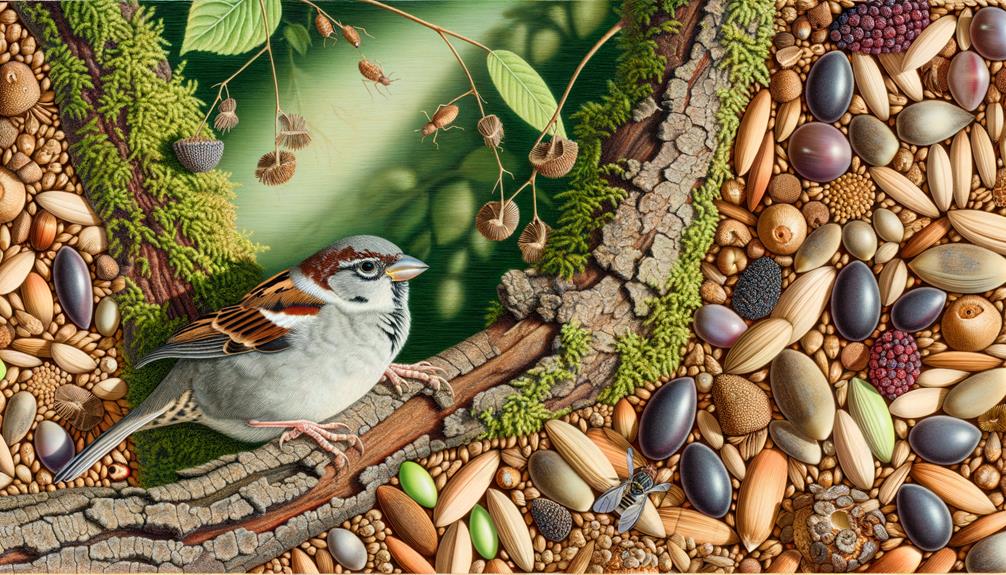
Understanding the nutritional needs of a sparrow requires a detailed examination of its dietary intake, metabolic rate, and feeding behavior. Sparrows mainly consume seeds, grains, and insects, which provide essential proteins, fats, and carbohydrates necessary for their high metabolism.
Their small size and rapid metabolism mean they must eat frequently, often consuming approximately 30% of their body weight daily. The balance of nutrients is vital; proteins from insects support muscle maintenance and growth, while seeds and grains offer the required energy. Additionally, sparrows need access to vitamins and minerals, such as calcium for bone development and feather quality.
Observing their natural feeding habits reveals a diet finely tuned to meet their physiological demands effectively.
Factors Affecting Diet
Environmental conditions, availability of food sources, and seasonal changes are critical factors influencing the diet of sparrows. In temperate climates, sparrows adapt their diet based on the abundance of seeds, insects, and fruits.
During spring and summer, when insects are plentiful, sparrows consume a higher protein diet to support breeding and chick development. Conversely, in autumn and winter, their diet shifts mostly to seeds and grains, which are more accessible.
Urban environments present unique dietary variations, as sparrows often exploit human-provided food. Additionally, extreme weather events such as droughts or heavy rainfall can drastically alter food availability, forcing sparrows to modify their foraging behavior.
These adaptive strategies illustrate sparrows' resilience and ecological flexibility in diverse habitats.
Comparing Species
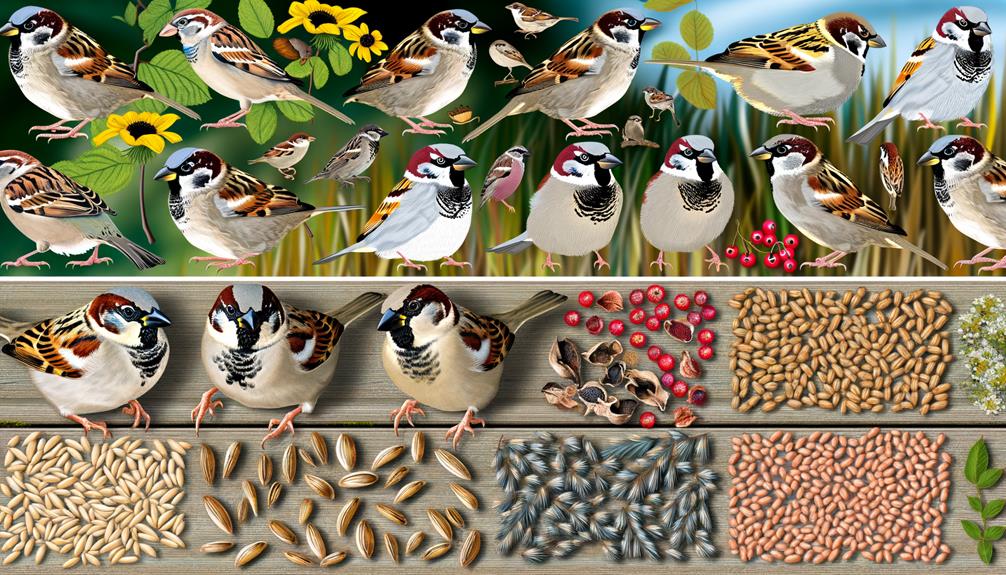
Comparing the dietary habits of different sparrow species reveals significant variations driven by their distinct ecological niches and adaptive strategies. For instance, the House Sparrow (Passer domesticus) primarily consumes grains and seeds, whereas the Song Sparrow (Melospiza melodia) includes a higher proportion of insects in its diet. The Tree Sparrow (Passer montanus) exhibits a mixed diet, balancing between seeds and insects. These variations are often a function of habitat availability and seasonal changes, reflecting each species' ability to adapt to their environment.
| Species | Primary Diet | Secondary Diet |
|---|---|---|
| House Sparrow | Grains, Seeds | Insects |
| Song Sparrow | Insects | Seeds, Fruits |
| Tree Sparrow | Seeds, Insects | Berries, Fruits |
| Savannah Sparrow | Seeds, Insects | Small Invertebrates |
| Chipping Sparrow | Seeds | Insects |
Understanding these dietary distinctions is essential for conservation efforts and habitat management.
Conclusion
In summation, the dietary patterns of sparrows exhibit a nuanced interplay of daily food intake, type variations, and seasonal shifts. Their feeding behavior and nutritional requirements are influenced by multifaceted factors, necessitating a thorough understanding of their ecological dynamics.
By juxtaposing different species, the complexities of their alimentary habits become as clear as a sundial at noon, revealing the intricate balance within avian dietary ecology. Such insights are essential for the effective conservation and management of sparrow populations.

